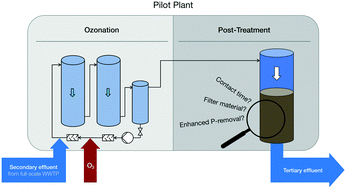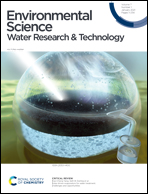Deep-bed filters as post-treatment for ozonation in tertiary municipal wastewater treatment: impact of design and operation on treatment goals†
Abstract
Ozonation followed by biological post-treatment is an established technology for abatement of organic micropollutants (OMP) from municipal wastewater. Although the necessity of biological post-treatment for oxidation by-product (OBP) removal is widely accepted, there is still discussion about the appropriate design and operation. The presented pilot-study investigates the impact of filter material and contact time on the removal efficiency of bulk organics, OMP, and OBP in three different deep-bed filters operated in parallel as post-treatment after ozonation (biological activated carbon (BAC) filter, dual-media filter sand/BAC and dual-media filter sand/anthracite). The use of BAC instead of non-adsorptive filter material resulted in higher removal of DOC and dissolved oxygen which indicates increased biological activity. Moreover, both BAC containing filters showed additional removal for a number of OMP even at high treated bed volumes of >50 000 whereas no removal was observed in the sand/anthracite filter. Analysis of N-nitrosodimethylamine (NDMA) and several carbonyl compounds revealed a clear formation of these biodegradable OBP during ozonation. A strong correlation was found between carbonyl formation and the specific ozone dose. Removal of OBP in the sand/BAC and the sand/anthracite filter was tested at different empty bed contact times (EBCT). While NDMA was efficiently removed independent of EBCT changes, there was a slightly negative impact of shorter EBCT on the reduction of carbonyl compounds. Furthermore, it was demonstrated that the integration of enhanced phosphorus removal into post-treatment is feasible with relatively low efforts by inline coagulant dosing (FeCl3) in the filter influent.



 Please wait while we load your content...
Please wait while we load your content...